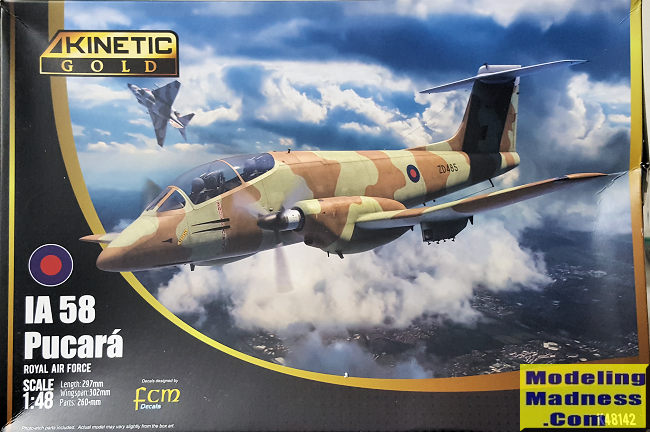
| KIT #: | K48142 |
| PRICE: | $43.00 delivered from China |
| DECALS: | One option |
| REVIEWER: | Scott Van Aken |
| NOTES: | 2023 release |

| HISTORY |
Their first actions came soon in 1975 when the first two aircraft were used against Bolivian insurgents. In 1978 all of the Pucaras were then flown to bases in Patagonia to provide support against possible incursions by Chilean forces. Next action was in 1982 in the Falkland Islands when Argentina's new military government invaded these British overseas islands. Due to the lack of prepared facilities, the Pucara was perfect as it was able to operate from unprepared and gravel runways, so a force was sent to provide protection for the invading forces. Unfortunately, the response from Britain was much greater than the leadership had anticipated. The result was a short and rather fierce conflict. Most of the Pucaras were destroyed on the ground by air attacks and British SAS operations. Three were shot down: one by a Sea Harrier, one by a Stinger SAM, and the other by small arms fire. Pucaras used in the Falklands were given various camouflage schemes over their peace-time bare metal finish.
Pucaras have also been used by Colombia, Uruguay and Sri Lanka, the latter using them against Tamil separatists who managed to destroy two of them. Manufacture ceased in 1988, with a total of 111 (including prototypes) built.
| THE KIT |
 It
was nice to see Kinetic produce a kit of this plane in 1/48 scale. Looking at
the instructions, it doesn't seem to be all that complex, consisting of five
grey sprues and one in clear. You get a well appointed interior with p.e. seat
harnesses. No decals for the instruments so you will need to paint those. There
are side wall inserts and the cockpit itself fits atop the nose wheel well. All
this leaves very little space for nose weight in the front so you'll have to add
most of your weight under the cockpit.
It
was nice to see Kinetic produce a kit of this plane in 1/48 scale. Looking at
the instructions, it doesn't seem to be all that complex, consisting of five
grey sprues and one in clear. You get a well appointed interior with p.e. seat
harnesses. No decals for the instruments so you will need to paint those. There
are side wall inserts and the cockpit itself fits atop the nose wheel well. All
this leaves very little space for nose weight in the front so you'll have to add
most of your weight under the cockpit.
The lower wings include a fairly large piece of the lower fuselage. Once the wheel wells are added, the upper wing halves end engine fronts can be added. There are two wing pylons and later in the build, you are provided two wing tank sizes and a triple ejector rack. No ordnance is included.
Once the wings and tailplanes are added, the
instructions would have you work on building up the landing gear and doors.
Personally, I'd hold off on these until after painting, but your choice. The kit
has separate flaps which are shown being built in the lowered position. These
can probably be adjusted to be raised as most images I've seen of this plane on the ground have
the flaps up. Another option is to have the canopy open, but again, this can be
posed lowered. Some of the larger p.e. bits are for canopy detail.
adjusted to be raised as most images I've seen of this plane on the ground have
the flaps up. Another option is to have the canopy open, but again, this can be
posed lowered. Some of the larger p.e. bits are for canopy detail.
Instructions are well done with MiG and FS 595 paint references. The lone option is the aircraft captured by the British during the Falklands war and returned to the UK for testing. The decal sheet for this one is tiny, but adequate. There are aftermarket decals if you want to build something different.
| CONCLUSIONS |
Those who have built this kit have generally liked it and comment that one does have to take care in construction as the tolerances are tight. It is a neat looking aircraft and one that will be a nice addition to your collection. As a side note, ordering kits from China can save you quite a bit of money. Downside is that they usually arrive with a fairly bent box. I've never had the contents damaged, but the box often takes a hit.
April 2024
Copyright ModelingMadness.com. All rights reserved. No reproduction in part or in whole without express permission from the editor.
If you would like your product reviewed fairly and fairly quickly, please contact the editor or see other details in the Note to Contributors.